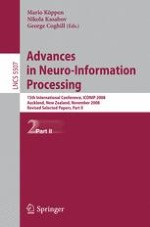The two volume set LNCS 5506 and LNCS 5507 constitutes the thoroughly refereed post-conference proceedings of the 15th International Conference on Neural Information Processing, ICONIP 2008, held in Auckland, New Zealand, in November 2008. The 260 revised full papers presented were carefully reviewed and selected from numerous ordinary paper submissions and 15 special organized sessions. 116 papers are published in the first volume and 112 in the second volume. The contributions deal with topics in the areas of data mining methods for cybersecurity, computational models and their applications to machine learning and pattern recognition, lifelong incremental learning for intelligent systems, application of intelligent methods in ecological informatics, pattern recognition from real-world information by svm and other sophisticated techniques, dynamics of neural networks, recent advances in brain-inspired technologies for robotics, neural information processing in cooperative multi-robot systems.
